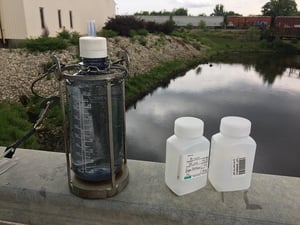In the last few years, per- and polyfluoroalkyl substances (PFAS) have come under harsh scrutiny for the risks they pose to human health and to our surrounding environment. Governing bodies like the United States Environmental Protection Agency (EPA) are studying them to determine what kind of regulations must be instituted to protect public health. This includes limitations on these chemicals in wastewater—PFAS contaminate our collection systems, and current methods are insufficient to eliminate or remove them during treatment.
What Are PFAS?
PFAS are long-lasting, manufactured chemicals that have been used in various consumer and industrial products since the 1940s. The most common PFAS are PFOS (perfluorooctane sulfonate) and PFOA (perfluorooctanoic acid). PFAS are commonly used to make fluoropolymer coating and products that resist heat, oil, stains, grease and water. Some common products that are made with PFAS include clothing, furniture, fire extinguishing foam, food packaging, non-stick cookware and electric wire insulation, among others.
 PFAS are dangerous because they don’t break down on their own, and eliminating these chemicals is extremely difficult. Additionally, they’re able to pass through our water and wastewater treatment systems—meaning that PFAS are eventually consumed by humans. Wastewater treatment plants can introduce PFAS into the environment through contaminated effluent discharge to surface water, land application of biosolids and disposal of residuals, and air emissions. And once they are present in wastewater supplies, PFAS easily transfer to drinking water.
PFAS are dangerous because they don’t break down on their own, and eliminating these chemicals is extremely difficult. Additionally, they’re able to pass through our water and wastewater treatment systems—meaning that PFAS are eventually consumed by humans. Wastewater treatment plants can introduce PFAS into the environment through contaminated effluent discharge to surface water, land application of biosolids and disposal of residuals, and air emissions. And once they are present in wastewater supplies, PFAS easily transfer to drinking water.
Currently, wastewater treatment plants (WWTP) are hypothesized to be one of the best places to control the spread of PFAS in the environment. “The goal is to eliminate the compounds from the effluent and drive them into the sludge, where they will be irreversibly bound and not available for uptake,” PFAS researcher Matt Simcik, Ph.D., explains. He continues: “Because municipal wastewater treatment plants are a bottleneck in the distribution of these compounds, they are one of the best places to remove them from circulation. We can’t eliminate [PFAS] from the broader environment. If we can drive them into biosolids and keep them from becoming available to plants or groundwater, that would be the best of both worlds.”
Where Are PFAS Found?
As the EPA notes, PFAS are extremely widespread: “Many PFAS are found in the blood of people and animals all over the world and are present at low levels in a variety of food products and in the environment.”
Several of the proven ways humans are exposed to PFAS include
- Working in firefighting or chemicals manufacturing
- Drinking contaminated water or eating certain foods (like fish) containing PFAS
- Breathing air contaminated with PFAS
- Using products made with PFAS
What Are the Potential Health Effects of PFAS?
Exposure to high amounts of specific PFAS has been linked to a range of adverse health outcomes, including decreased fertility, increased risk of kidney or testicular cancers, developmental delays in children, and reduced vaccine response.
Research on the effects of PFAS is still ongoing. Unfortunately, health experts struggle to study the potential health and environmental impacts of PFAS because there are thousands of varieties of these chemicals. PFAS types and uses also change over time, so how and when people are exposed is often unclear. It is still uncertain to what degree humans are exposed to PFAS, how harmful PFAS are to people and the environment, how to manage and dispose of PFAS, and how to remove PFAS from drinking water.
While much about PFAS remains unknown, researchers have determined that groups who may be more sensitive to the effects of PFAS or might have increased exposure rates to these chemicals are industrial workers, pregnant and lactating women, and children.
What Is the Connection Between PFAS and Wastewater?
 In September 2021, EPA published the Preliminary Effluent Guidelines Program Plan 15 (Preliminary Plan 15), which includes its first proposed limits to PFAS in wastewater. The Multi-Industry Per- and Polyfluoroalkyl Substances (PFAS) Study was also published as part of Preliminary Plan 15. This study examined industrial PFAS manufacturing, use, treatment, and discharge to surface water and privately owned treatment works (POTWs), and determined that effluent guidelines were necessary for PFAS manufacturers. Preliminary Plan 15 catalyzed the initiation of limits on organic chemicals, plastics and synthetic fibers (OCPSF) manufacturers and metal finishing manufacturers regarding how much PFAS they can discharge from their facilities. It also announced the initiation of detailed studies of PFAS discharges from landfills and textile mills.
In September 2021, EPA published the Preliminary Effluent Guidelines Program Plan 15 (Preliminary Plan 15), which includes its first proposed limits to PFAS in wastewater. The Multi-Industry Per- and Polyfluoroalkyl Substances (PFAS) Study was also published as part of Preliminary Plan 15. This study examined industrial PFAS manufacturing, use, treatment, and discharge to surface water and privately owned treatment works (POTWs), and determined that effluent guidelines were necessary for PFAS manufacturers. Preliminary Plan 15 catalyzed the initiation of limits on organic chemicals, plastics and synthetic fibers (OCPSF) manufacturers and metal finishing manufacturers regarding how much PFAS they can discharge from their facilities. It also announced the initiation of detailed studies of PFAS discharges from landfills and textile mills.
Scientists are currently researching solutions for eliminating PFAS compounds from both drinking water and wastewater. Applying cationic polymers to wastewater sewage sludge is one possible solution. Using reverse osmosis and granular activated carbon have been effective at treating drinking water for PFAS, but these are often rather expensive processes. Both of these methods still leave utilities with the problem of contaminated materials disposal; PFAS cannot be disposed of in landfills because they could leach into the surrounding environment. Incineration is being studied as a potential disposal method of the chemicals.
New PFAS treatments are under investigation, but researchers are still a long way from understanding these long-lived chemicals. Learn more about EPA’s effluent guidelines and efforts to address PFAS here: https://www.epa.gov/eg
Now that you've got the latest on PFAS in wastewater, learn the fundamentals of sewer maintenance with our FREE guide, Sewer Maintenance 101: A Quick and Dirty Guide to Sewer Inspection and Upkeep.

